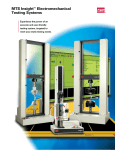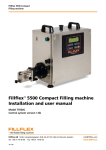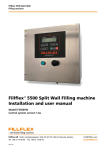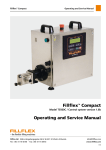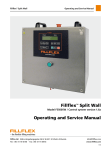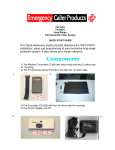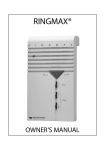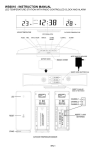Download User manual - Bellman & Symfon
Transcript
Overview On/Off and settings Installation LED lights Ext trig input Microphone 1 Remove the battery pull tab to start the baby monitor. 2 Place the baby monitor on the nightstand or hang it on the wall with the screw and plug. The recommended distance is 0.5-2 m, out of reach from the child. 1 Turn off: Press and hold both buttons for 3 s Switch on: Press and hold both buttons for 1 s 19 EN 2 Contact mat 20 Testing Settings 1 Stand by the child’s bed and make a noise. 2 The Visit receiver lights up a pacifier symbol and indicates with sound, lights or vibrations (depending on the receiver). If it doesn’t react, read the section Settings. The buttons for sensitivity and delay are located on the baby monitor’s left side. When you press the button, the LED shows the current setting. Then press repeatedly to adjust the setting. If the baby monitor isn’t activated when the baby cries – increase the sensitivity. If the baby monitor is activated too easily – reduce the sensitivity. If the baby monitor is activated too fast or too slow – adjust the delay. 1 2 EN Sensitivity Red LED High Orange LED Medium Green LED Low Delay Red LED 30 s Orange LED 10 s Green LED 1s 21 2 22 Installing a contact mat Technical information By using a contact mat, you can also be notified if your child gets out of bed. Just place the mat in front of the crib, connect it to the baby monitor and it will tell you when your child steps on it. Power supply Power consumption Operating time Activation Radio frequency Coverage Number of radio keys EN Battery power: 2 x 1.5 V AA (LR6) lithium or alkaline batteries. Active < 70 mA, Idle position < 400 μA Alkaline ~ 6 months, Lithium ~ 1 year Via the test buttons, microphone or a contact mat via the ext trig 315 MHz, 433.92 MHz or 868.3 MHz depending on region 50 - 250 m depending on radio frequency. Coverage is reduced by walls, large objects and other radio transmitters. 64 as standard. Up to 256 with optional software. Additional information Please note BE9024 Contact mat (sold separately) 23 Always make sure the baby monitor is out of the child’s reach. Never place the baby monitor in the child’s crib or playpen. Usage and storage For indoor use only. Temperature: 15°- 35° C. Rel. humidity: 5% - 95%. Maintenance and cleaning Maintenance free. Clean with a dry cloth. Don’t use household cleaners, aerosol sprays, solvents, alcohol, ammonia, or abrasives. Not reusable. Safety and regulations For information on safety and regulations, see the Installer’s Guide. Service and support For information on service and support, see the Installer’s Guide. 24 Installer’s Guide 77Introduction 79Installation 81Testing 83Settings 84 Default indication and signals 85 Customizing the signal 89 Trouble shooting 91 Technical information 76 Introduction Overview Function The baby monitor is part of the Visit alerting system that helps people with hearing loss to notice signals in their home. When your child cries, the baby monitor signals the Visit receiver that notifies you with sound, lights or vibrations (depending on the receiver). This way you are always close to your baby. On/Off and settings LED lights Ext trig input Microphone Activation The baby monitor can be activated by either: The test buttons (press simultaneously) The built-in microphone The BE9024 Contact mat accessory (connected to the Ext trig input) Settings The baby monitor allows you to adjust the sensitivity and delay and you can set a unique signal for each child, so you know who needs your attention. 77 Turn off: Press and hold both buttons for 3 s Switch on: Press and hold both buttons for 1 s Contact mat 78 Installation Installing a contact mat 1 Remove the battery pull tab to start the baby monitor. 2 Place the baby monitor on the nightstand or hang it on the wall with the screw and plug. The recommended distance is 0.5 - 2 m, out of reach from the child. By using a contact mat, you can also be notified if your child gets out of bed. Just place the mat in front of the crib, connect it to the baby monitor and it will tell you when your child steps on it. 1 2 BE9024 Contact mat (sold separately) 79 80 Testing Advanced testing 1 Stand by the child’s bed and make a noise. 2 The Visit receiver lights up a pacifier symbol and indicates with sound, lights or vibrations (depending on the receiver). If it doesn’t react, read the section Advanced testing. Testing the baby monitor is easy. First, make sure that the baby monitor is installed properly. For instructions, read the section Installation. 1 Using the test button Press both test buttons simultaneously. 1 The baby monitor’s LED lights up to show that a radio signal is transmitted. 2 The receiver’s pacifier symbol lights up to show that the signal was received. 2 Using the microphone Activate the baby monitor by whistling or speaking into the microphone. 1 The baby monitor’s LED lights up to show that a radio signal is transmitted. If you have adjusted the delay, it will be postponed as shown on page 83. 2 The receiver’s pacifier symbol lights up to show that the signal was received. If you have customized the signal pattern, it will blink as shown on page 85. 81 2 If it doesn’t work as described, read the section Troubleshooting. 82 Settings Default indication and signal The buttons for sensitivity and delay are located on the baby monitor’s left side. When you press the button, the LED shows the current setting. Then press repeatedly to adjust the setting. If the baby monitor isn’t activated when the baby cries – increase the sensitivity. If the baby monitor is activated too easily – reduce the sensitivity. If the baby monitor is activated too fast or too slow – adjust the delay. Transmitter indication When the baby monitor is activated, the LED indicator lights up in green. This means that the batteries are in good condition. Change batteries if the LEDs blink in orange. Only use 1.5 V AA (LR6) lithium or alkaline batteries. Sensitivity Red LED High Orange LED Medium Green LED Low Delay Red LED 30 s Orange LED 10 s Green LED 1 s 83 Receiver signal When a receiver is activated, it signals with sound, flashes or vibrations. The default signal pattern is as follows: Signal pattern 868/315 MHz 433 MHz Transmitter rce Receiver Source LED LED Sound Vibration Flash Baby Green, top Orange Baby melody Rapid pattern Yes Contact mat Green, bottom Green 1 x ding dong, Lo Slow pattern Yes Baby Green, top Orange Baby melody Slow pattern Yes Contact mat Green, bottom Green 1 x ding dong, Lo Slow pattern Yes 84 Customizing the signal The baby monitor controls the signal pattern on the receiver. By moving a signal switch A up=on you can set a unique signal for each baby. Note that you need to move the other switches down. Changing the radio key A On Off Signal pattern 868/315 MHz 433 MHz Source Switch LED Sound Vibration Flash Baby 1 1 Orange light Baby melody Rapid pattern Yes Baby 2 2 2 x orange blink Baby melody Rapid pattern Yes Baby 3 3 3 x orange blink Baby melody Rapid pattern Yes Baby 4 4 Blinking in orange Baby melody Rapid pattern Yes Baby 1 1 Orange light Baby melody Slow pattern Yes Baby 2 2 Orange light 2 x ring, Lo Fast pattern Yes 85 If you install multiple systems, you can set a unique radio key for each system to avoid interference. Move any radio key switch B to the up=on position to change radio key. B On Off Please note All Visit products within the same system must be set to the same radio key in order to operate as a group. All Visit products are set to the same radio key from factory and all radio key switches are positioned down=off per default. 86 Signal output for 868 MHz and 315 MHz Dip switch 87 Signal output for 433 MHz Output Test button 1or 2 Internal Mic External trigger Output Test button 1or 2 Internal Mic External trigger Light Orange light Vibration Rapid pattern Green light Light Orange light Green light Slow pattern Vibration Slow pattern Sound Slow pattern Baby melody 1 x ding dong, Lo Sound Baby melody 1 x ding dong, Lo Light 2 x orange blinks 2 x green blinks Light Orange light Green light Vibration Rapid pattern Slow pattern Vibration Fast pattern Fast pattern Sound Baby melody 2 x ding dong, Lo Sound 2 x ring, Lo 1 x ring, Hi Light 3 x orange blinks 3 x orange blinks Light Orange light Orange light Vibration Rapid pattern Rapid pattern Vibration Slow pattern Slow pattern Sound Baby melody Baby melody Sound 2 x ding dong, Lo 2 x ding dong, Lo Light Blinking in orange Blinking in orange Light Orange light Orange light Vibration Rapid pattern Rapid pattern Vibration Slow pattern Slow pattern Sound Baby melody Baby melody Sound Baby melody Baby melody Dip switch 88 Trouble shooting If Try this If Try this Two orange lights appear every 10s • Change the batteries. Only use 1.5 V AA (LR6) lithium or alkaline batteries. The baby monitor is activated too easily • Reduce the sensitivity or move the baby monitor further away from the crib, see Settings. A green light appears on the baby monitor but the receiver is not activated • Check the baby monitor’s and the receiver’s batteries and plugs. The baby monitor is activated too fast • Increase the delay. For more information, read the section Settings. The baby monitor is activated too slow • Reduce the delay. For more information, read the section Settings. The baby monitor is not activated even though the baby is crying • Move the baby monitor closer to the baby or increase the microphone’s sensitivity, see Settings. The receiver is activated for no reason • There is probably another Visit system nearby that triggers your system. Change the radio key on all units, see Changing the radio key. 89 • Move the receiver closer to the baby monitor. • Check that the baby monitor and the receiver are set to the same radio key. For more information, read the section Changing the radio key. • Please note: Always make sure the baby monitor is out of the child’s reach. Never place the baby monitor in the child’s crib or playpen. 90 Technical information Power supply Power consumption Operating time Activation Radio frequency Coverage Number of radio keys Battery power: 2 x 1.5 V AA (LR6) lithium or alkaline batteries. Active < 70 mA, Idle position < 400 μA Alkaline ~ 6 months, Lithium ~ 1 year Via the test buttons, microphone or a contact mat via the ext trig 315 MHz, 433.92 MHz or 868.3 MHz depending on region 50 - 250 m depending on radio frequency. Coverage is reduced by walls, large objects and other radio transmitters. 64 as standard. Up to 256 with optional software. Additional information Security Always make sure the baby monitor is out of the child’s reach. Never place the baby monitor in the child’s crib or playpen. Usage and storage For indoor use only. Temperature: 15°- 35° C. Rel. humidity: 5% - 95%. Maintenance and cleaning Maintenance free. Clean with a dry cloth. Don’t use household cleaners, aerosol sprays, solvents, alcohol, ammonia, or abrasives. Not reusable. Warranty and service If your baby transmitter appears to be damaged or doesn’t function properly, follow the advice in this booklet and the online resources. If it still doesn’t function properly, contact your retailer for information about obtaining warranty service. 91 Hereby, Bellman & Symfon declares that this Baby monitor is in compliance with the essential requirements and other relevant provisions of directives: R&TTE 1999/5/EC, LVD 1973/23/EC, EMC 1989/336/EC, MDD 1993/42/EEC. FCC compliance statement This device complies with Part 15 of the FCC Rules. Operation is subject to the following two conditions: (1) this device may not cause harmful interference, and (2) this device must accept any interference received, including interference that may cause undesired operation. Warning: Changes or modifications to this unit not expressly approved by the party responsible for compliance could void the user’s authority to operate the equipment. Note: This equipment has been tested and found to comply with the limits for a Class B digital device, pursuant to Part 15 of the FCC Rules. These limits are designed to provide reasonable protection against harmful interference in a residential installation. This equipment gener- Use and disposal of batteries Replace only with the same or equivalent type recommended by the manufacturer. Please dispose of old, defective batteries in an environmentally friendly manner in accordance with the relevant legislation in your country. ates, uses and can radiate radio frequency energy and, if not installed and used in accordance with the instructions, may cause harmful interference to radio communications. However, there is no guarantee that interference will not occur in a particular installation. If this equipment does cause harmful interference to radio or television reception, which can be determined by turning the equipment off and on, the user is encouraged to try to correct the interference by one or more of the following measures: • Reorient or relocate the receiving antenna. • Increase the separation between the equipment and receiver. • Connect the equipment into an outlet on a circuit different from that to which the receiver is connected. • Consult the dealer or an expe- rienced radio/TV technician for help. For a complete Declaration of Conformity please contact the Bellman & Symfon European office. accept any interference, including interference that may cause undesired operation of the device. Le fonctionnement de cet équipement est soumis aux conditions suivantes: (1) l’équipement concerné ne doit pas causer d’interférences, et (2) il doit accepter toute interférence reçue, y compris les interférences risquant d’engendrer un fonctionnement indésirable. Cet appareil numérique de la classe B est conforme à la norme NMB-003 du Canada. This Class B digital a paratus complies with the Canadian ICES-003. Industry Canada statement This device complies with Industry Canada Licence-exempt RSS-210. Operation is subject to the following two conditions: (1) this device may not cause interference, and (2) this device must Zusätzliche Information Nur Innen verwenden. Wartungsfrei. Reinigung mit einem nur leicht feuchten Tuch. HMV 16.99.09.0045 European office Bellman & Symfon Europe AB Södra Långebergsgatan 30 421 32 Västra Frölunda Sweden Phone: +46 31 68 28 20 E-mail: [email protected] Asia Pacific office Bellman & Symfon Asia Ltd. 1115-16, Main Tower, Int’l Hotel 339 Huanshi Dong Rd Guangzhou, China, 510095 Phone: +86 20 8318 2950 E-mail: [email protected] 92 bellman.com BE1491_049MAN005 DESIGN FOR EARS™
















